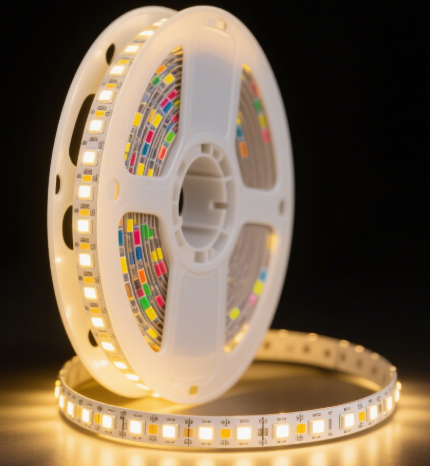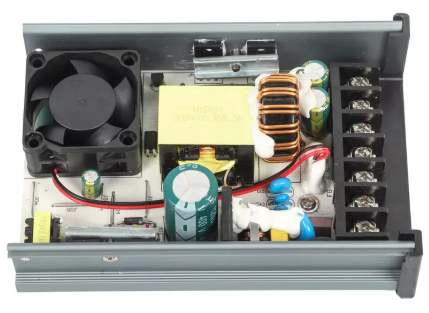Author: Site Editor Publish Time: 2025-08-04 Origin: Site
LED strip lights are becoming a popular choice for both decorative and functional lighting due to their flexibility and energy efficiency. However, connecting them to a 12V power supply correctly is crucial for safety and performance. In this post, we’ll guide you through the essential steps to safely connect your LED strip lights to a 12V power supply, ensuring optimal performance and longevity.
A 12V LED strip light operates on low voltage, typically requiring a 12V power source to function properly. These strips are commonly used in various lighting applications due to their flexibility and energy efficiency. Unlike traditional bulbs, LED strips offer versatile lighting solutions that can be cut to fit specific spaces and easily installed on walls, ceilings, or furniture.

Use Case | Description |
Home Decoration | LED strips are ideal for creating ambient lighting in living rooms, bedrooms, or kitchens. |
Functional Lighting | Commonly used under cabinets, along stairways, or for task lighting. |
Accent Lighting | Often used to highlight certain areas or objects, adding visual appeal to rooms. |
To operate correctly, LED strip lights require a consistent and specific voltage, which is where a 12V power supply comes in. A 12V power supply ensures that the LED strips receive the right amount of power to function efficiently without overheating or malfunctioning. Using a power supply with the incorrect voltage can lead to dim lighting, or in extreme cases, damage the LEDs or the power supply itself.

It’s crucial to match the voltage of the power supply (12V) with the LED strip’s requirements. Mismatched power sources can result in poor performance, reduced lifespan, or even damage to both the power supply and the LED strip. For instance, using a power supply with higher voltage than the strip’s rating can cause the LEDs to burn out. On the other hand, a lower voltage supply might not provide enough power, leading to flickering or dim lighting.

The first step in connecting your LED strip lights to a 12V power supply is correctly identifying the polarity. Both LED strips and power supplies have positive (+) and negative (-) terminals, and it’s crucial to connect them properly. If the polarity is reversed, the LED strip may fail to light up or could be damaged.
LED Strip: Look for clear markings along the copper pads or wires indicating “+” for positive and “-” for negative. These marks ensure you’re connecting the wires correctly.
Power Supply: Power supplies typically use color-coding to distinguish the terminals—red for positive (+) and black for negative (-). Confirm the markings before making the connection.
There are several methods to connect your LED strips to the 12V power supply, depending on the type of LED strip you’re working with.
LED Strip with Open Wires to Power Supply: If the LED strip has open wires, twist the positive wire of the LED strip to the positive terminal of the power supply and the negative wire to the negative terminal. Use a wire connector to secure the wires and ensure there are no exposed connections.
LED Strip with DC Plug to Power Supply: If the LED strip has a DC plug, simply plug the DC male connector into the female DC socket on the power supply. Ensure the voltage and polarity match to avoid any damage to the strip.
To properly make the connections, you’ll need a few essential tools and materials:
Wire Cutters: To trim the wires to the correct length for your setup.
Wire Strippers: To remove the insulation from the wire ends for proper connections.
Soldering Iron (optional): If you choose to solder your connections for a more permanent solution.
Wire Connectors: To twist and secure the wires together, ensuring a stable connection.
Heat Shrink Tubing or Electrical Tape: To insulate and protect the connections from short circuits or exposure.
For a quick and easy connection, twist the wires together using a wire connector. Make sure the connection is tight and secure. A wire nut or another suitable connector can help hold the wires together firmly and prevent accidental disconnections.
If you prefer a more permanent connection, use a soldering iron to solder the wires to the LED strip and power supply terminals. After heating the soldering iron, apply the solder to the terminal and wire. Once it cools, cover the connection with heat shrink tubing or electrical tape to insulate it and prevent any accidental shorts.
Proper insulation of all exposed wire connections is critical to prevent short circuits. Ensure that no bare wire is touching any metal surfaces, and use heat shrink tubing or electrical tape to cover the wire ends. This will protect the connection and ensure your setup is safe and secure.
Once everything is connected, it’s time to test your setup. Turn on the power supply and check if the LED strip lights up. If the strip does not light up, double-check the following:
Loose Connections: Ensure all wires are firmly twisted or soldered and that no wires are loose.
Correct Polarity: Verify the positive and negative connections match correctly between the LED strip and the power supply.
Proper Voltage: Ensure the power supply is providing the correct voltage (12V) for your LED strip.
If the strip still doesn’t light up, further troubleshoot by checking for any potential wiring mistakes or damaged components.
It’s essential to match the power supply’s voltage with the LED strip’s required voltage—12V in this case. Using the wrong voltage can damage the LED strip or cause it to malfunction.
Under-voltage: If the power supply provides less voltage than required, the LED strip may not light up properly or could flicker.
Over-voltage: On the other hand, excessive voltage can burn out the LEDs or shorten their lifespan.
When choosing a power supply, ensure its capacity matches the power required by the LED strip. You can calculate the power needed by multiplying the wattage of the LED strip per meter by its total length.
For a 5-meter LED strip that uses 10W per meter:
Power required = 5 meters * 10W = 50W
Choose a power supply with a higher capacity than 50W to avoid overloading. A 60W power supply would work well.
The length and gauge of wires can impact the efficiency of your LED strip setup. Longer wires or thinner wires cause voltage drop, meaning less power reaches the LED strip.
Longer wire runs: Use thicker wires (lower gauge) to minimize voltage drop and power loss.
Recommended wire type: For runs longer than 5 meters, use at least 18 AWG wire for minimal voltage loss.
To prevent damage and ensure safe operation, securing and protecting connections is crucial:
Cable clips and adhesive-backed cable holders can help keep wires in place and prevent accidental disconnections.
Use heat shrink tubing or electrical tape to insulate the connections and protect them from environmental factors, especially for outdoor use.
If installing outdoors, ensure all connections are waterproofed using waterproof connectors or enclosures to prevent water damage.
Grounding your power supply is crucial, especially if it has a metal housing. Grounding helps prevent electrical shock and fire hazards.
If the power supply is grounded, it provides a safe pathway for any excess electricity to flow, reducing the risk of a short circuit.
Always follow proper safety precautions when working with electrical systems, including using insulated tools and checking for power before making adjustments.
When connecting multiple LED strips to a single 12V power supply, it’s important to choose the right type of connection. The two main options are series and parallel connections.
Series Connection: Connecting LED strips in series is not recommended for most setups. In this configuration, the current flows through each strip one after another, leading to voltage drop and inconsistent brightness across the strips.
Parallel Connection: This is the preferred method. Each LED strip is connected directly to the power supply, ensuring they all receive the same voltage. Parallel connections help maintain consistent brightness and allow for easier maintenance.
In some cases, you might need to use multiple power supplies to power a single LED strip, especially when the strip exceeds the capacity of one power supply.
When to Use Multiple Power Supplies: This method is used when the power requirement of a long LED strip exceeds the wattage output of a single power supply. For instance, if a 12V, 100W LED strip is too much for a 60W power supply, two power supplies may be necessary.
Best Practices:
Ensure both power supplies are from the same manufacturer and product series.
Connect the power supplies in parallel, not series, to avoid uneven load distribution.
Split the LED strip into sections to ensure both power supplies handle only part of the load.
If your LED strip doesn’t light up or behaves unpredictably, there are a few common issues to check.
LED Strip Doesn’t Light Up:
Loose connections: Ensure all connections are tight and properly secured.
Incorrect polarity: Double-check that the positive terminal of the power supply is connected to the positive terminal of the LED strip, and vice versa.
Improper voltage: Confirm that the power supply is providing the correct voltage (12V) for your LED strip.
Flickering or Dimming LED Strips:
Voltage drop: Long wire runs or undersized wires can cause a voltage drop. Make sure you’re using the correct wire gauge.
Overloading the power supply: Ensure the total wattage of the connected LED strips doesn’t exceed the power supply’s rating. If the power supply is overloaded, the strips might flicker or dim.
Q: Can I use a higher voltage power supply with 12V LED strips?
A: Using a higher voltage power supply than 12V can burn out the LED strips. LED strips are designed for specific voltage, and over-voltage can damage their components permanently.
Q: Can I use a dimmer with my 12V LED strip?
A: Yes, you can use a dimmer with a 12V LED strip. Ensure the dimmer is rated for 12V LED systems, and connect it in series with the power supply to control brightness without harming the strip.
Q: How long can I run LED strips on a single power supply?
A: The maximum length depends on the power supply’s wattage. For example, a 12V power supply with 60W can power up to 5 meters of 12V LED strip that consumes 10W per meter.
Q: Can I cut LED strips to fit my space?
A: Yes, you can cut LED strips along the marked lines. After cutting, ensure proper connections using connectors or soldering to reconnect the strips.
To connect your LED strips safely, ensure voltage compatibility, correct wiring, and secure connections. Always test the setup to make sure everything works properly. For optimal performance, follow best practices for insulation and use the right tools. Proper installation helps prevent damage and ensures long-lasting functionality.